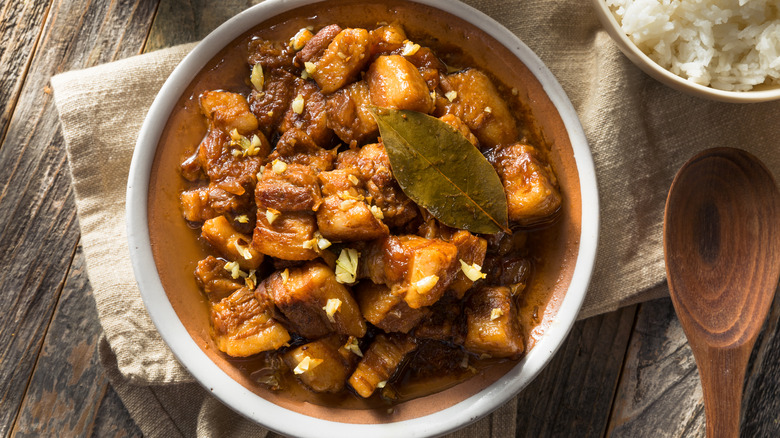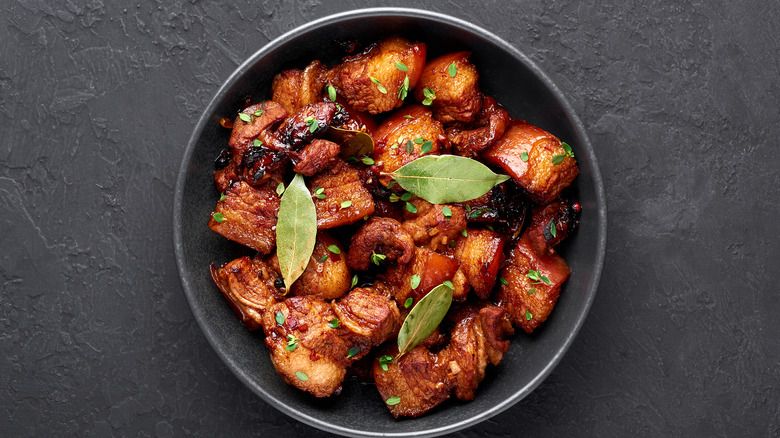How Adobo Became A Filipino Staple
What adobo is depends on where you are and who you are asking, because different varieties of adobo exist in parts of the Spanish-speaking world. In Spain, adobo is a marinade made with vinegar, as well as a mix of spices that include oregano, salt, garlic, and black pepper. In Mexico, adobo comes two ways: as a paste made with chiles, and to which is added aromatics like onions, garlic, cumin, and oregano; as well as in chiles preserved in adobo sauce. In the Caribbean, adobo is a spice rub, made with paprika, oregano, cumin, garlic powder, onion powder, and turmeric, as well as the spice base for a marinade to which vinegar is added. And even as there are many different forms of adobo, all can agree that the word itself is Spanish in origin, and comes from the word adobar, or to marinade.
But what of Philippine adobo, the dish that has captivated Filipino food fans everywhere — and even merited a cooking lesson for Anthony Bourdain on an episode of "Parts Unknown:Manila?"
Adobo was around before Spanish conquerors arrived the Philippines
Historian Ambeth Ocampo says that while Philippine adobo might have a very Spanish-sounding name, its origins go back to before Portuguese explorer Ferdinand Magellan first set foot on the archipelago in 1521. The only trouble was, the original name of that pre-Hispanic cooking method was never recorded.
The first written record of adobo in the Philippines appears in a 1612 book compiled by one Pedro de San Buenaventura, who had written about a dish he called adobo de los naturales because it was similar to something already found in Spain and Mexico. But historians like Ocampo argue that even before Magellan and his ships arrived, the pre-Hispanic Filipinos had already learned to cook meat in different ways, because they had to find ways to keep protein from spoiling in the humid, tropical climate. The enterprising natives were said to have used steaming and boiling. They also used plenty of vinegar and salt; and thanks to Chinese traders who swung by the archipelago from time to time, they even knew how to use soy sauce, which is an essential ingredient in today's adobo. Still, it would be safe to say that the nameless, vinegared meat dish that existed before it became adobo would have been quite different from the dish we know today.
There are many different ways to cook adobo
While adobo was always a hit with Filipino food fans outside of the Philippines, media outlets credit Anthony Bourdain for shining a spotlight on the often-overlooked cuisine. When he filmed "Parts Unknown: Manila" Bourdain had the opportunity to enjoy a home cooked adobo meal, made with pork, chicken, garlic, vinegar, peppercorns, bay leaf, and soy sauce. And while that style best known in the west, it is only one of many different forms of adobo in the country, and — each is unique to the area it is prepared in.
In the northern province of Batangas, annatto water can take the place of soy sauce, resulting in a low-sodium, red-tinted form of adobo. Further south, adobo is enjoyed sa gata — or with coconut milk and green finger chilis in place of black peppercorns. There is white adobo, or adobong puti, which does away with soy sauce and bay leaf which are considered later additions. Then there is adobo with sliced banana flowers in white vinegar, and shrimp paste. One popular way of cooking up leftover adobo is to fry the meat until it becomes crisp — this way, adobo is flaked and used to top any dish.
Adobo is not the exclusive domain of chicken and pork either, because it can be made with squid or water spinach, known locally as kangkong. As historian Ambeth Ocampo writes, there are "at least 21.8 million adobo recipes and variants based on the estimated number of households in the Philippines today."


